Celtic Cross Spread
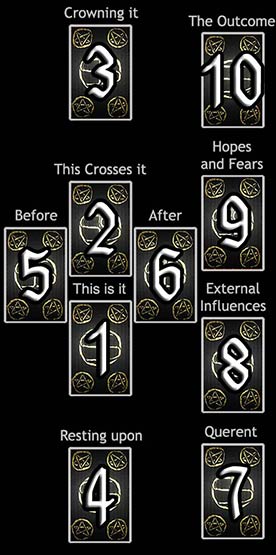
Difficulty: Average
This is probably the most well-known tarot spread. A good, basic spread for beginners to practise with, the Celtic Cross is useful for questions of all types. In this spread, it can be helpful to notice the relationships between the pairings of cards #5 & #9, #1 & #2, #3 & #4, and #6 & #10.
- The significator epitomizes what the reading deals with, the initial situation.
- An added impulse that compounds the significator, which may be either complimentary or contradictory.
- This is what is consciously known (thoughts).
- Unconscious driving forces that may not be known fully (emotions).
- The immediate past regarding the current situation.
- The first future card indicates the immediate future.
- This card represents the reader and their attitude towards cards #1 and #2.
- The external influences, the places and people which influence the topic.
- This tarot card suggests expectations; what is secretly hoped for or feared.
- The second future card reveals the long-term outcome.
Your Celtic Cross Reading
The Crown |
The Outcome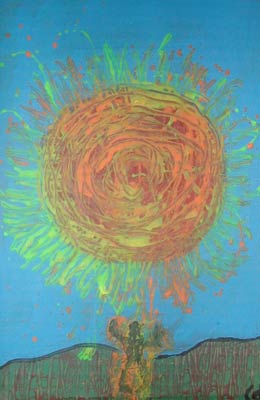 XIX. The Sun
External Forces 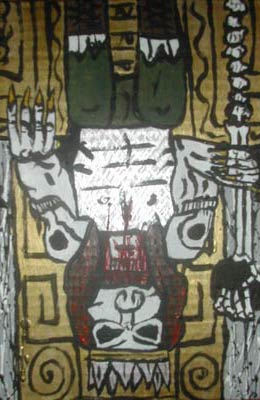 IV. The Emperor
|
||
The Recent Past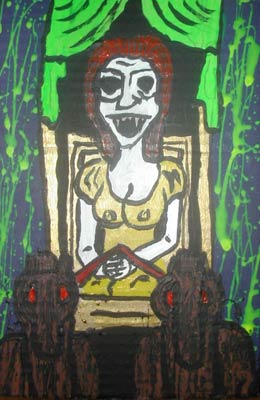 VII. The Chariot |
The Crossing Card
|
The Future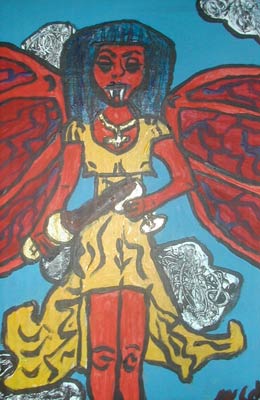 XIV. Temperance |
|
|
|||
The Significator represents what the main theme of the reading deals with, the initial situation.
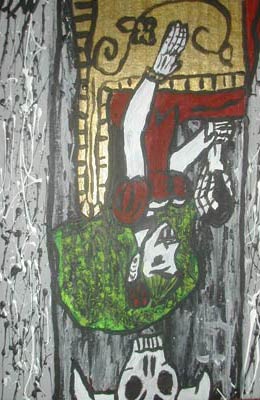
III. The Empress
Reversed
Symbolism:
The Empress sits upon her throne, her presence commanding yet nurturing. She holds the Hand of Glory, a macabre artifact symbolizing her power to claim whatever she desires. Her surroundings are lush and fertile, with dark roses blooming amidst the decay—symbols of beauty and abundance arising from even the grimmest conditions. Her expression is one of calm authority, radiating life-giving energy.
Meaning:
The Empress represents creation, fertility, and the nurturing aspects of life. She signifies abundance and the ability to bring ideas, projects, or relationships to fruition. This card invites you to connect with your creative or maternal instincts and embrace the cycles of growth and renewal. It may also point to emotional or physical abundance and a celebration of life's pleasures.
Reversed, the Empress warns of stagnation, overbearing tendencies, or emotional imbalance. It may point to neglect, smothering, or difficulties in manifesting creativity.
Keywords:
Reversed: Stagnation, neglect, overbearing, creative block, emotional imbalance.
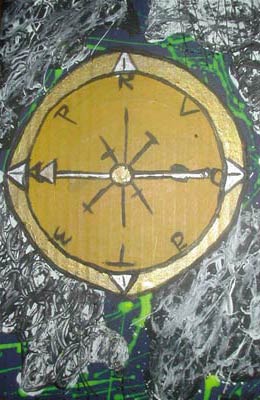
The Crossing Card denotes an added impulse that compounds the initial card, whether complimentary or contradictory.
X. The Wheel of Fortune
Reversed
Symbolism:
The Wheel of Fortune appears as a rotating wheel carved from black obsidian, inscribed with arcane runes glowing faintly in red and gold. Around the wheel, shadowy figures—some triumphant, others despairing—are caught in its orbit, symbolizing the cyclical nature of fate. At its center, a single, unblinking eye peers outward, embodying the watchful presence of destiny and the unpredictable forces that govern life.
Meaning:
The Wheel of Fortune represents cycles, change, and the influence of fate. It reminds you that life is constantly shifting between highs and lows, and adaptability is key to navigating these changes. When this card appears, it often signals a turning point, a shift in fortune, or the hand of destiny at work. It encourages you to seize opportunities while being mindful of the bigger picture.
Reversed, the Wheel warns of resistance to change, misfortune, or feeling stuck in a negative cycle. It suggests learning from setbacks to break free and regain control.
Keywords:
Reversed: Stagnation, resistance, bad luck, missed opportunities, instability, lack of control.
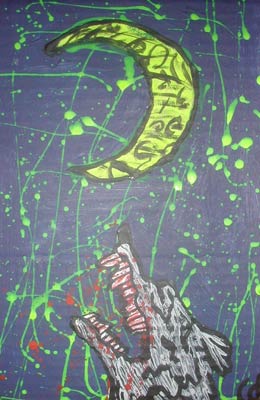
The Crown stands for what the asker is aware of consciously.
XVIII. The Moon
Symbolism:
The Moon is depicted as a blood-red orb casting an eerie glow over a desolate landscape. Two wolves—one dark and one light—howl at the moon, representing instinct and duality. A twisted, thorn-covered path winds between them, leading into a dense forest shrouded in mist. Shadows shift and twist unnaturally, suggesting the illusions and fears that dwell in the subconscious.
Meaning:
The Moon symbolizes intuition, dreams, and the realm of the subconscious. It warns of illusions, hidden truths, or fears clouding your judgment. This card encourages trusting your instincts and exploring your inner world to uncover what lies beneath the surface.
Keywords:
Upright: Intuition, dreams, subconscious, illusion, mystery, emotions, uncertainty.
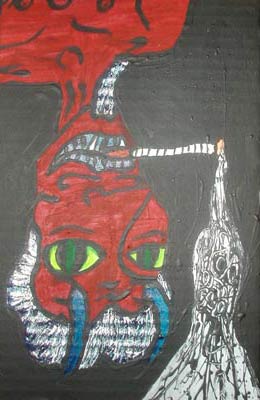
Foundation card reveals unconscious driving forces that the querent may not be aware of.
XV. The Devil
Reversed
Symbolism:
The Devil is portrayed as a towering, horned figure shrouded in shadow, with glowing crimson eyes and skeletal bat wings. Chains dangle from its outstretched hands, tethered to two figures who appear entranced rather than distressed, symbolizing voluntary bondage. A fiery pit burns at its feet, while the moon above is obscured by dark clouds, representing ignorance and illusion. Behind the Devil, a cracked mirror reflects hidden desires and fears.
Meaning:
The Devil signifies temptation, materialism, and self-imposed limitations. It highlights the darker aspects of human nature, such as obsession, addiction, or unhealthy attachments. This card often serves as a wake-up call to recognize and confront these influences, reclaiming your power and freedom.
Reversed, the Devil suggests breaking free from negative patterns or regaining control over impulses. It may indicate the first steps toward liberation or an awakening from illusion.
Keywords:
Reversed: Freedom, release, awareness, breaking cycles, regaining power, self-determination.

The Recent Past represents past events and concerns.
VII. The Chariot
Symbolism:
The Chariot is a sinister yet majestic vehicle drawn by two spectral horses, one black and one white, representing opposing forces. A Nosferatu figure stands at its helm, cloaked in shadows, holding a whip of shadowy tendrils. The chariot races through a mist-laden nightscape, its wheels crushing fallen leaves and brittle bones, symbolizing the journey's sacrifices and challenges.
Meaning:
The Chariot signifies determination, control, and the will to overcome obstacles. It calls for focused effort and harnessing conflicting energies to achieve a goal. This card often appears when decisive action and self-discipline are needed to navigate a complex situation. It encourages you to take charge of your direction and steer with purpose.
Keywords:
Upright: Determination, control, focus, discipline, willpower, triumph, direction.

The Future depicts that which lies ahead.
X. The Wheel of Fortune
Reversed
Symbolism:
The Wheel of Fortune appears as a rotating wheel carved from black obsidian, inscribed with arcane runes glowing faintly in red and gold. Around the wheel, shadowy figures—some triumphant, others despairing—are caught in its orbit, symbolizing the cyclical nature of fate. At its center, a single, unblinking eye peers outward, embodying the watchful presence of destiny and the unpredictable forces that govern life.
Meaning:
The Wheel of Fortune represents cycles, change, and the influence of fate. It reminds you that life is constantly shifting between highs and lows, and adaptability is key to navigating these changes. When this card appears, it often signals a turning point, a shift in fortune, or the hand of destiny at work. It encourages you to seize opportunities while being mindful of the bigger picture.
Reversed, the Wheel warns of resistance to change, misfortune, or feeling stuck in a negative cycle. It suggests learning from setbacks to break free and regain control.
Keywords:
Reversed: Stagnation, resistance, bad luck, missed opportunities, instability, lack of control.
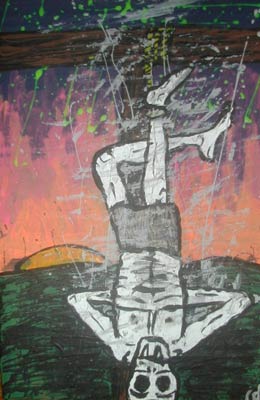
The Querent represents the asker and their attitude towards the subject of the reading.
XII. The Hanged Man
Symbolism:
The Hanged Man is shown suspended upside-down from a barren tree, his foot bound by a chain of silver. His expression is serene, as if willingly surrendering to his predicament. A pool of crimson liquid forms beneath him, reflecting a full moon, symbolizing surrender and the potential for transformation. Surrounding him, shadows twist into shapes of wings, hinting at the freedom that comes through letting go.
Meaning:
The Hanged Man represents surrender, perspective, and the need to pause. It encourages you to let go of control and view a situation from a different angle. This card often signals a period of waiting or self-sacrifice, where stepping back can lead to greater understanding or personal growth.
Keywords:
Upright: Surrender, perspective, pause, letting go, reflection, patience, transformation.

External Forces represents the influence of others in your life as well as trends in your relationships with others.
IV. The Emperor
Reversed
Symbolism:
The Emperor is a Nosferatu seated on a blood-soaked throne, gripping the Hand of Glory as his scepter of authority. His crimson cloak flows like a river of lifeblood, symbolizing his dominion over life and death. Behind him, a craggy fortress rises, representing stability and the structures of power. His stern, commanding gaze reinforces his role as a protector and enforcer of order.
Meaning:
The Emperor symbolizes authority, stability, and protection. He represents the need for structure and discipline to achieve goals and maintain order. As a figure of leadership, he encourages reason and conviction in decision-making. This card often indicates a time to take control of your environment or to rely on a strong, supportive figure for guidance.
Reversed, the Emperor warns of rigidity, tyranny, or a loss of control. It may signify struggles with authority, immaturity, or the misuse of power.
Keywords:
Reversed: Tyranny, rigidity, immaturity, chaos, rebellion, over-control.
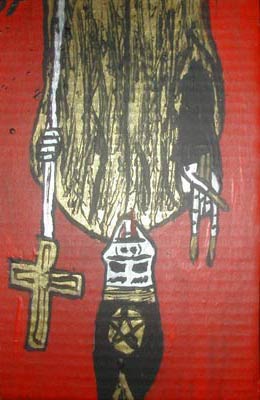
Hopes and Fears shows the expectations you have concerning the outcome of your question.
V. The Hierophant
Reversed
Symbolism:
The Hierophant stands in a candlelit crypt, robed in dark ceremonial attire. His face is obscured by a mask resembling a skull, emphasizing his role as a mediator between the living and the dead. In his hands, he holds an ancient grimoire, its pages glowing faintly as if infused with sacred knowledge. Behind him, shadowy figures bow in reverence, symbolizing tradition and the transfer of esoteric teachings.
Meaning:
The Hierophant represents tradition, spiritual guidance, and conformity to established systems of belief. He serves as a bridge between the divine and the mundane, reminding you to honor time-tested wisdom and moral values. This card often calls for introspection about your relationship with tradition and how it shapes your choices. It may also suggest seeking counsel or mentorship from someone with greater experience or spiritual authority.
Reversed, the Hierophant challenges the rigidity of traditions, encouraging independent thought and nonconformity. It warns against blind faith in systems that may no longer serve you.
Keywords:
Reversed: Nonconformity, rebellion, outdated beliefs, spiritual doubt, dogmatism.

The Outcome of your question. Interpret this card in the context of the entire reading and as an indicator of the path you are currently on, but not necessarily bound to.
XIX. The Sun
Symbolism:
The Sun features a radiant figure standing atop a stone altar, their outstretched arms ablaze with golden light. Behind them, a massive blood-red sun dominates the sky, casting warm, revitalizing rays over a once-shadowed landscape. Sunflowers bloom vibrantly in the foreground, representing vitality and joy. A golden wolf stands beside the figure, symbolizing loyalty and enlightenment.
Meaning:
The Sun represents joy, success, and clarity. It heralds a period of positivity, growth, and accomplishment, reminding you to embrace life with enthusiasm and gratitude. This card suggests that challenges are behind you, and a brighter path lies ahead.
Keywords:
Upright: Joy, success, clarity, vitality, growth, positivity, accomplishment.
